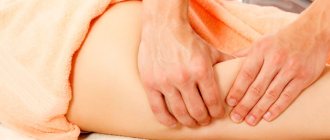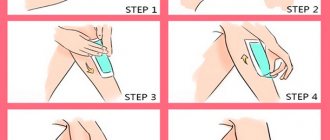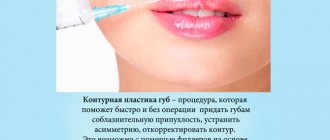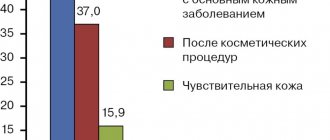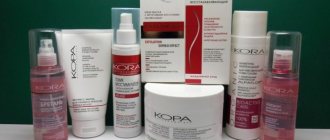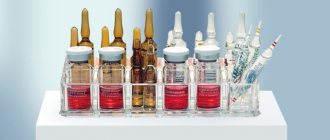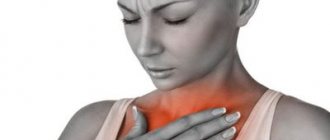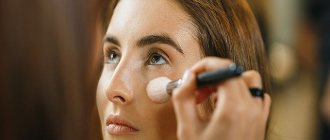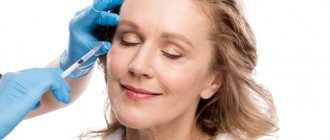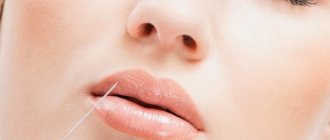From this article you will learn:
- how to remove nasolabial folds,
- reviews, before and after photos,
- side effects and complications.
Having nasolabial folds is normal human anatomy, but these folds can become deeper with age. Deepening of the nasolabial folds occurs primarily due to age-related changes in the skin and subcutaneous fat, gradually leading to gravitational ptosis (drooping) of the soft tissues of the buccal area. Additional influences include exposure to the sun, active facial expressions, and smoking. Patients note that pronounced nasolabial folds give the face a tired look, and ask to make them less noticeable.
The most effective and safe way to make them less noticeable is contouring with fillers based on hyaluronic acid. The method involves injecting a gel based on stabilized hyaluronic acid into the base of the fold. The gel smoothes out the area of soft tissue depression due to the fact that it is able to maintain its volume in the soft tissues for a long time. Depending on the type of filler, the effect can last from 6 to 18 months.
Nasolabial fillers: before and after photos
Correction of nasolabial folds with fillers based on hyaluronic acid is the simplest option for facial contouring, which is not too complicated even for novice cosmetologists. A much more complex correction option is the use of semi-permanent and permanent fillers (for example, based on microspherical particles of calcium hydroxyapatite or particles of poly-L-lactic acid), i.e. drugs such as Radiesse or Sculptra. Working with such fillers will require experience, as well as specialized training in working with such drugs.
But there is a large group of patients in whom correction with fillers will be completely ineffective. Firstly, we are talking about patients with a deformational (edematous) type of aging, who, due to impaired venous outflow and microcirculation, develop increasing interstitial edema of soft tissues (mainly due to subcutaneous fatty tissue). And secondly, in patients with pronounced fat deposits in the cheek area. You can read what to do in these situations below in the “Complicated cases” section.
Correction of nasolabial folds: procedure progress
Before directly starting to inject filler into the nasolabial folds, it is important to decide on the correct treatment strategy, because in this case there are 2 options for correction. The first option is that the filler is injected directly into the area of the nasolabial folds, using one of the injection techniques or a combination of them. The second option is that filler can be injected into the cheekbone area, which will increase their volume and tighten the skin + straighten the nasolabial folds.
In patients with pronounced cheekbones and round cheeks, it is best to actually correct the nasolabial folds themselves, however, in patients with thin cheeks and a small amount of soft tissue, it is better to inject filler into the cheekbone area, because this will give the best aesthetic result. Or a combined correction option is possible, when filler is injected into both the cheekbones and nasolabial folds (the choice of correction option will depend on the severity of the result you expect to see and your budget).
Above, we allowed ourselves to say that this is a fairly simple technique even for novice cosmetologists. This is true if we consider the complexity of correcting nasolabial folds with the correction of other areas of the face. But this relatively simple technique also has subtle points, some of which can make the procedure more effective, while others can lead to complications. Particular attention here should be paid to the upper third of the nasolabial fold, where the angular branch of the facial artery passes, and it is very important not to damage it and avoid embolism (24stoma.ru).
Contraindications to the procedure –
We should not immediately start injecting fillers into the nasolabial folds. At the first stage of communication with the patient, we must assess the medical history and the presence of contraindications to the procedure, after which the patient must fill out an informed consent form for filler injections. There are a number of contraindications for the use of fillers based on hyaluronic acid (including for the correction of nasolabial folds) -
- pregnancy and lactation,
- oncology (even if clinical recovery is achieved - at least 5 years must pass from this moment + permission from the oncologist has been obtained, since there is evidence that injections of hyaluronic acid can contribute to relapse),
- against the background of acute infectious diseases,
- inflammatory processes in the area of intervention,
- autoimmune diseases,
- tendency to form keloid scars,
- if the patient was previously injected with semi-permanent and permanent fillers in this area, or fillers of unknown origin.
In addition, if you have a pathology of the thyroid gland, then this can also be regarded as a relative contraindication. Against the background of this pathology, the destruction of fillers in tissues occurs much faster compared to ordinary patients, and therefore the duration of the effect can be several times shorter. The risk group also includes patients who often use corticosteroid ointments on the skin of the face (they develop granulomas much more often), people who abuse tanning, as well as patients with diabetes.
Choosing a filler for the procedure –
To correct nasolabial folds, denser fillers are used than, for example, to correct superficial wrinkles or to increase lip volume. The final choice will depend on the severity of the nasolabial folds: the deeper they are, the denser the filler with hyaluronic acid should be used. For example, for moderate folds you can use fillers Juvederm Ultra 3, Juvederm Volift, Restylane, Belotero Balance.
For deep folds – Juvederm Ultra 4, Restylane-Perline, Belotero Intense. All of the fillers listed above have FDA recommendations for the correction of nasolabial folds (with the exception of Juvederm Volift, as it is a recently introduced drug). There are a number of cheaper fillers - such as Princess Volume, Hyalax Base and others - that can also be used. However, these fillers are less flexible and behave worse in mobile areas; when used, gel displacement may occur more often.
As for the required volume of filler, usually 1.0 ml of filler is enough to correct moderately severe nasolabial folds (0.5 ml on each side). It is best to choose fillers without lidocaine for correction, because... the latter can lead to temporary whitening of the tissue at the injection site (especially with superficial injection), simulating ischemia, which is a symptom of vascular complications of the injection and requires urgent cessation of the procedure.
However, not only HA-based fillers, but also semi-permanent/permanent fillers can be used to correct nasolabial folds. Their undoubted advantage is their longer-lasting effect, but at the same time, the number of complications after their use reaches, according to various authors, even about 40-50%. Therefore, we still recommend using safer bioresorbable fillers based on hyaluronic acid.
Anesthesia –
If a 13 mm needle is used to correct nasolabial folds, then anesthesia is carried out using a cream or gel containing the anesthetic Lidocaine (the concentration of which in products of different brands varies from approximately 5 to 12%).
The cream is applied to the surface of the skin at the site of intended injection for about 20-25 minutes, after which it is washed off, and the skin is treated several times with antiseptic solutions. If the cannula technique is used, the injection site is numbed with an injection of local anesthetic. This again can be either Lidocaine, or Ultracaine, or some other anesthetics without or with a small content of vasoconstrictor components. Below we will look at the techniques of working with a needle and cannula separately.
Injection techniques (needle) –
In order to remove nasolabial folds, the linear-retrograde technique and its variations are used. For injections, a 13 mm long needle or a long flexible cannula can be used. The use of a needle implies that after injection, the needle moves parallel to the skin in the middle or deep layers of the dermis to the end to its entire length, and the material is removed with a retrograde movement of the needle back. We consider correction of nasolabial folds with a needle to be preferable, because... this anatomical area is relatively safe, and the needle is much easier to control in the tissue.
a) The first version of the classical linear technique implies that the filler is removed along the nasolabial fold, i.e. along it. To do this, needle injections are made at certain intervals of 13 mm to go through the entire length of the nasolabial fold (just short of reaching the wing of the nose, as well as the corner of the mouth). The first injection is made 13 mm from the wing of the nose, and at this moment it is very important to do an aspiration test. Injecting the needle to its full length each subsequent time, we should not immediately begin to remove the material, but first carry out a small separation of the tissues with characteristic movements of the needle (this is necessary for good distribution of the material).
Linear technique for correcting nasolabial folds: video
A complicated version of this technique is a fan technique (Fig. 3), when from one injection point not one linear pass is made with a needle with the material being removed while the needle moves retrogradely backwards, but several passes are made without completely removing the needle from the skin, each time changing its direction . Moreover, each time, remember to separate the tissue a little with a needle before removing the material. Do not forget about the aspiration test to prevent embolism of the angular branch of the facial artery, which runs near the wing of the nose.
b) The second option is to use a linear-retrograde technique in such a way that the material is removed perpendicular to the direction of the nasolabial fold in tracks of 10-12 mm (Fig. 5). First, we stretch the skin with our hands to completely smooth out the nasolabial fold. Next, we make sequential injections, moving in the direction from the wing of the nose to the corner of the mouth, perpendicular to the direction of the nasolabial fold. The material is removed by retrograde movement of the needle; each needle injection takes approximately 0.03 ml of filler, the distance between injections is 1.0-1.5 mm. In total, each nasolabial fold usually requires about 15-20 needle passes.
Important: there are a number of clinical studies comparing the effectiveness and duration of the results of the two above techniques. Moreover, for clarity, in the same patients, the correction was carried out as follows: the nasolabial fold on the left was filled with a linear technique along the direction of the fold, and on the right side, a linear technique with a perpendicular direction of injections was used. Below you can see the results of these techniques in before and after photos of patients (Fig. 5-6). Photos of patients are taken from a clinical study, which can be viewed here.
Please note that the appearance of those nasolabial folds (see Fig. 5-6, after 4 weeks), the correction of which was performed perpendicular to the direction of the fold with injections, is somewhat better than where the classic linear injection technique was used in the direction of the folds. However, the advantages of both techniques can be used simultaneously by using a third correction option.
c) The third option is a combination of the first two techniques. This option first involves a linear passage with a 13 mm needle along the entire length of the nasolabial fold (do not forget about separating the tissues before removing the material), after which we pass perpendicularly several times, leaving the so-called “stiffening ribs” at a distance of 5 mm from each other. Do not forget about the depth of needle insertion, so if the material is removed too superficially, both contouring of the material and its translucency through the skin are possible (Tyndall effect).
Injection techniques (cannula) –
To remove filler into tissue, not only 13 mm long needles can be used, but also long cannulas (have a blunt end). This method has the following advantages: firstly, there is only one injection point on each side, and secondly, there is less risk of damage and embolism to blood vessels. The insertion point for the cannula is near the corner of the mouth. The injection site must be numbed with an injection of local anesthetic.
Next, using a needle, we create a puncture in the skin and the direction of insertion of the cannula, and only after that we insert the cannula into the tissue, moving it to the base of the nasolabial fold at the wing of the nose. Before removing the material, it is advisable to separate the tissues by moving the tip of the cannula. Next, we make several passes (fan technique), removing the material with a retrograde movement of the cannula back. A digital passage of the excretion area is required.
Correction of nasolabial folds with cannulas: video
Fillers - review by a cosmetologist
Juvederm is a good quality product. But to treat all the required areas on the face, fillers of different densities are needed. The name is the same (One brand), but the density is different.
Is this drug safe?
Real drugs are safe, but there is always a nuance: No matter how qualified a cosmetologist is, no matter how carefully he follows the technique, there is always the possibility of some undesirable phenomena.
Fillers, like drugs, are different. There are branded certified drugs, and there are fillers that are much cheaper than certified ones. For example, in clinics the average cost of filler is 15-17 thousand rubles, and in the cosmetology market they offer filler for 8 thousand rubles. And if it is a drug of the same brand, then you should seriously think about counterfeiting. Since a certified filler purchased from an official distributor cannot cost so cheap.
No matter how qualified the cosmetologist is and no matter how carefully he follows the technique, there is always the possibility of some undesirable phenomena. This is unlikely, they happen rarely, but they still happen. You should definitely check the qualifications of the doctor before going for the procedure. You need to ask your cosmetologist what product he will use. Don't be shy and ask questions that concern you.
Especially if something bothers you after the procedure has already been performed, be sure to let your doctor know. This way you will avoid possible complications.
The advantage of hyaluronic acid is that it has an ANTIDOTE - hyaluronidase. If suddenly a vessel occlusion or an allergic reaction occurs (which is extremely rare with hyaluronic acid), we have the opportunity to remove this drug. Antidotes - hyaluronidase and longidase - are placed directly in the area where hyaluronic acid was injected and the filler dissolves literally immediately. It begins to turn into water and is excreted from the body.
The principle of resorption is simple. When the deadline expires, the filler is absorbed due to our own hyaluronidase, which is in our body, but if it needs to be removed urgently, then an injection of the antidote hyaluronidase is administered. For example, you didn’t like the effect achieved and you decided to return everything back.
How long does the effect last?
The effect for the cheek-zygomatic area from the volumizer lasts, according to informed consent and according to the product label, for 12-18 months. On average, it lasts this way in reality, gradually settling over a year and a half. In the nasolabial areas from a year to 14 months. On the lips, usually up to 1 year.
Filler injection - injection
We add a small volume to the lip area, very delicately. It’s not so much that the effect itself disappears, but the patient gets used to the natural volume and literally after a month it seems - So what? Did we stage anything?
When you show a photo before the procedure, it becomes obvious that there is an effect, and the patient quickly gets used to the natural volume. After the effect wears off and all the fillers (hyaluronic acid injections) injected under the skin turn into water, won’t I look worse?
Cosmetologist Yuliana ShiyanComment from cosmetologist, dermatologist Yuliana Shiyan:
I always give an example: When we (girls) start using shapewear, get in shape and then take it off, we have more fat and a thicker waist, it doesn’t get any better! It's the same with fillers and threads.
After we put the drug on and it dissolved, for no reason at all the face will not get worse. The question arises when the patient forgets how it was. And naturally he wants to repeat the aesthetic effect that was at the beginning.
This is an aesthetic addiction, not a physiological one. If suddenly a Woman becomes pregnant or for some reason suddenly decides not to take the drug anymore, then her face will not be worse than because she was once injected with fillers. The face will age naturally, as it did before the introduction of fillers.
Fillers. Video with comments from a cosmetologist
Fillers. Detailed review and application practice
Here I have Juvederm with lidocaine in my hands, expiration date until November 2020. Such drugs are always opened directly in the presence of the patient. This is an individual syringe and already filled. Contrary to the wishes of the patients, to divide it between girlfriends, he does not share. For example: Botox is drawn up multiple times with a sterile syringe from one bottle.
Juvederm comes with a drug passport. It is stuck in the “Informed Consent” Drug VOLUMA
So that there is no misunderstanding between the doctor and the patient, or doubts about the integrity of the doctor whom the patient sees for the first time. The doctor is obliged to open the syringe with filler in the presence of the patient and after administering the filler, show the empty syringe. So that the patient can see that an expensive injection has been given and there is no drug in the syringe. So that there are no questions: Have you given me everything? Here the doctor insures himself.
Contour plastic surgery of nasolabial folds: price
For contour plastic surgery of nasolabial folds, the price in professional dermatological clinics starts from 10,000 rubles (for 2022). The final cost will depend on the brand and volume of filler. For example, the cost of correction when using 1.0 ml of Juvederm Ultra 3 or Ultra 4 will be about 13,000 - 14,000 rubles, Restylane or Perlane - 16,000 rubles.
The cost of services from private cosmetologists is usually somewhat lower, but we immediately draw your attention to the fact that too low prices can only indicate the use of counterfeit drugs, the volume of use of which, according to statistics, already reaches 40% of the total volume of drugs. For example, the cost of the Juvederm Ultra 3 filler alone is about 7,000 rubles, and the Restylane line of drugs ranges from 8,000 to 10,000 rubles. Therefore, if you are offered a final cost of 7000-8000 rubles, then this is only possible if you use counterfeit drugs or fakes.
Side effects and complications –
The most dangerous complications that can be encountered during the correction of nasolabial folds with hyaluronic acid fillers are vascular complications. They arise, firstly, due to the introduction of a large amount of filler near the vessel, which can lead to its compression and disruption of blood circulation in this area. Secondly, the vessel may be damaged by a needle (rarely by a thin cannula), which can lead to embolism due to filler entering directly into the lumen of the vessel.
In these cases, ischemia first occurs, accompanied by tissue whitening, which, if no assistance is provided, can progress to tissue necrosis. Whitening of tissues without pain indicates compression of the vessel, and whitening with sharp pain is a symptom of embolism. But in rare cases, tissue whitening can be caused by the presence of the anesthetic lidocaine in the filler, simulating ischemia. Treatment of ischemia and embolism must be urgent and require injections of hyaluronidase.
Examples of some complications -
Another complication is the Tyndall effect, which occurs when fillers that are too dense are injected too superficially. This leads to a change in the refraction of light and the fact that bluish or pinkish stripes begin to appear under the skin at the places where the filler was introduced. If such an effect occurs, it can only be eliminated by dissolving the filler using hyaluronidase injections.
Granulomas are another complication, but they are more common with semi-permanent and permanent fillers than with hyaluronic acid fillers. However, this is also possible when using HA fillers. Granulomas in the form of small bubbles on the surface of the nasolabial folds arise due to the fact that the body reacts to the filler as a foreign body and tries to isolate itself from it using a capsule of granulomatous tissue (granulomas can be either inflammatory or non-inflammatory in nature).
Granulomas often form when fillers contain high levels of residual substances used to stabilize (crosslink) hyaluronic acid molecules. This component includes, for example, BDDE. Its recommended residual concentration in the filler should not exceed 0.9-1.0%, and therefore you should not choose very cheap fillers.
Preparations for contouring
The list of fillers that can transform your appearance is quite extensive. New ones are constantly appearing, but it is important that the drug has a certificate and is approved by the FDA and Roszdravnadzor, confirming its safety and quality.
GMTClinic uses classic fillers from the best foreign manufacturing companies:
- Juvederm (France) - hyaluronic acid gels containing lidocaine for a painless procedure. Juvederm Volift and Juvederm Volume can correct nasolabial folds, correct the shape of the cheekbones and chin. To fill severe wrinkles and correct the shape of the nose, GMTClinic specialists choose Juvederm Ultra. Juvederm Smile gels are suitable for lip augmentation.
- Restylane (Sweden) - fillers from this manufacturer were among the first to be used in cosmetology. Gel fillers “Restylane”, “Restylane Vital”, “Restylane Perline” and “Restylane Sub-Q” have proven themselves in excellent reviews and are used for procedures in various areas, including the skin of the neck and décolleté.
- Belotero (Germany) - this line of the German company MertzFarma is represented in GMTClinic by gels with lidocaine Belotero Soft and Belotero Balance. While the first drug fills facial wrinkles well and refreshes the skin, the second is injected into the cheekbone area to make it possible to restore lost tissue volumes, as well as eliminate scars and correct wrinkles of varying depths.
- Revaness Pure (Canada) - the filler provides a long-lasting effect due to its longer retention in the skin. It copes well with both expression lines and more pronounced wrinkles. It is used to smooth out nasolabial folds, enlarge lips, and add volume to cheekbones.
- Radiesse (USA) - drugs from this manufacturer are intended to correct skin changes associated with insufficient tone and hydration. A good effect is achieved by filling sagging, flabby tissue in the chin and cheek area. According to numerous reviews, it removes scars well.
- Yvoire (Korea) - new generation gels from the manufacturer LGScience. The series consists of three fillers: Yvoire Hydro, Yvoire Classic and Yvoire Volume. The drugs vary in viscosity and are injected into the skin at different depth levels. Due to the special structure of the drugs, the results of their use are noticeable over a longer period of time.
- ReDexis (Canada) - high-tech skin rejuvenation in different areas of the body. Together with hyaluronic acid, the drug contains special microspheres that attract substances to the injection site for the synthesis of its own collagen. The skin is renewed and remains fresh and tight for a long time.
- Etermis (Russia - Germany) - two types of hyaluronic acid allow you to quickly restore skin hydration and take care of volume. The composition also includes mannitol, which prolongs the lifting effect. For small wrinkles, use Etermis 3, and for pronounced wrinkles, use the denser Etermis 4 gel.
- Novacutan FBio (France) - a unique formula ensures uniform distribution of filler in tissues, preventing movement. The line consists of three drugs: Light, Medium and Volume. They differ in density and are used in various areas of the face: from the nasolacrimal groove to the chin.
- Neauvia (Nyuvia) (Italy) - preparations of ultra-pure hyaluronic acid. GMTClini uses the following fillers from this line: INTENSE FLUX (for delicate areas in the eye area, etc.), STIMULATE (for correcting deep folds) and STIMULATE MAN, designed taking into account the characteristics of men's skin.
- Endoret Gel (Spain) - the drug is obtained using a special technology using the patient’s own blood. After administration, the gel starts the process of skin renewal, slowing down aging at the cellular level. Allows you to eliminate wrinkles of varying depths in the eyes, lips and chin.
- AestheFill (South Korea) is a powerful stimulator of collagen production. Ball-shaped microspheres actively interact with skin cells, helping to smooth out wrinkles and create new tissue. The quality of the skin noticeably improves, and the effect lasts up to two years.
- Sculptra (Sculptra) (USA) - this filler is made on the basis of polylactic acid, which makes its use possible even in those patients who do not want to use hyaluronic acid. An excellent result for severe signs of aging is achieved by stimulating collagen synthesis, filling lost volumes and moisturizing the skin, with a gradual increase in effect, and lasts up to two or more years.
Complex cases of correction –
In some cases, the volume of overhanging tissue in the cheek area is so large that correction may require a whole bucket of fillers. We have already said above that this happens in two groups of patients, and in particular in the presence of pronounced “fat bags” in the cheek area. In this case, it is optimal to achieve a reduction in adipose tissue using lipolytic injections (approved for use on the face) + plus the parallel use of vascular drainage drugs.
The second group of patients are patients with deformational (edematous) type of aging. Such patients usually always have problems with the spine in the cervical-collar area, and due to prolonged spasm of the muscles in this area, the venous outflow in the soft tissues of the face and neck is disrupted. As a result, microcirculation and lymphatic drainage are disrupted, which lead to the development of interstitial edema, primarily of subcutaneous fat. As a result, the volume and mass of tissue increases, which leads to gravitational ptosis, including in the area of the nasolabial folds.
What to do in this case. In order to fully solve the problem, you need to normalize venous outflow, microcirculation and lymphatic drainage. This is done by conducting a course of capillary mesotherapy/lymphatic drainage vascular injection, which will remove interstitial edema, thereby reducing the volume of soft tissues of the face (including the severity of nasolabial folds). And only after this should the question of the need for further correction of nasolabial folds with fillers be resolved.
But you must understand that only the use of capillary mesotherapy in patients with the edematous type of aging (without correction of problems in the cervical-collar area) will only give a temporary effect. Treatment should include not only periodic courses of therapeutic massage and acupuncture, but even, for example, the correct choice of office chair if you have a sedentary job, is critically important. You can’t even imagine how quickly the wrong chair can lead to problems with the spine, and, as you now understand, even aggravate the aging of the face.
Surgiderm
This is a multicomponent drug from France. The main active ingredient of Surgiderm is hyaluronic acid. Thanks to additional components, hyaluronate forms additional bonds in the skin and forms a matrix structure. The acid becomes more stable and dissolves much more slowly than other representatives. The three-dimensional structure also prevents Surgiderm from migrating under the skin or being displaced by external factors.
Injections are carried out only to medium and deep depths. Contour correction in the sensitive area around the eyes is not carried out with this drug.
Surgiderm 24 XP has a high density and is ideal for camouflaging nasolabial folds and moderate wrinkles. Using this ruler, you can lift the cheekbone area and give the missing volume to the lips.
Surgiderm 30 XP. The series is distinguished by its viscosity and is used mainly to increase volume where it is lacking. The drugs are effective against deep wrinkles. In the forehead area, a cosmetologist can not only smooth out the skin, but also raise the corners of the eyebrows. The eye will become more open, the face will take on a fresh and rested appearance. Series 30 XP is also used for lip contouring.
Surgiderm is compatible with other preparations containing hyaluronate. The result lasts up to 1.5 years.
Exercises for nasolabial folds –
Some people claim that exercise can strengthen the muscles surrounding the nasolabial folds, potentially making them less noticeable. Nevertheless, it is believed that active facial expressions associated with contractions of the facial muscles, on the contrary, lead to a deepening of the nasolabial folds. There are no clinical studies on this issue. The complex for nasolabial folds includes the following exercises, which are recommended to be done every day -
- Pucker your lips while lifting them towards the tip of your nose and hold for 15 seconds (repeat 4-5 times).
- Pucker your lips so they appear fuller, then pull the corners of your mouth outward and hold for 15 seconds (repeat 4-5 times).
- With your mouth slightly open, pull the corners of your mouth with your index fingers, moving them further apart, and hold for 2-3 seconds (repeat 25 times). We hope that our article was useful to you!
Sources:
1.
, 2. Personal experience with fillers, 3. National Library of Medicine (USA), 4. https://aestheticsjournal.com, 5. “Cosmetic dermatology” (L. Bauman), 6. “Anatomy & volumizing injections” (Nabila Azib, Philippe Berros, Frederic Braccini).
Anatomy of nasolabial folds and factors influencing their severity
A clear understanding of facial anatomy is a key aspect in the effectiveness of anti-age procedures, including those involving the introduction of fillers into the nasolabial folds. The nasolabial lips are located in the middle third of the face and run diagonally from the wings of the nose to the corners of the lips.
They deepen when smiling as the facial muscles—the zygomatic major, zygomatic minor, and levator labii superioris—move the upper lip in a superolateral direction. When we smile, the upper lip goes under the malar fat compartments, which protrude forward.
The lateral nasal artery is located in close proximity to the nasolabial fold - 2-3 mm above the depression near the wings of the nose - and is the main source of blood supply to the tip and wings of the nose.
Nasolabial folds are absent in early childhood, but with age they become noticeable even when the face is motionless. Such changes are caused by various factors, including:
- loss of facial tissue volume;
- ptosis of the malar fat compartment;
- collagen atrophy in the dermis;
- loss of skin elasticity.
The severity of nasolabial folds also depends on the tonic activity of the facial muscles, which can be clearly seen in the example of patients with facial nerve paresis - their nasolabial folds disappear.
Anti-age procedures: contour plastic surgery of the middle third of the face.
The severity of nasolabial folds also depends on the tonic activity of the facial muscles, which can be clearly seen in the example of patients with facial nerve paresis - their “nasolabial folds” disappear.
Some of the above factors can be neutralized by injecting HA fillers into the nasolabial folds. The following issues are discussed in more detail below:
- 3Lift technique;
- patient selection;
- practical guide to filler injection;
- choice of filler and technique, restrictions after the procedure.
